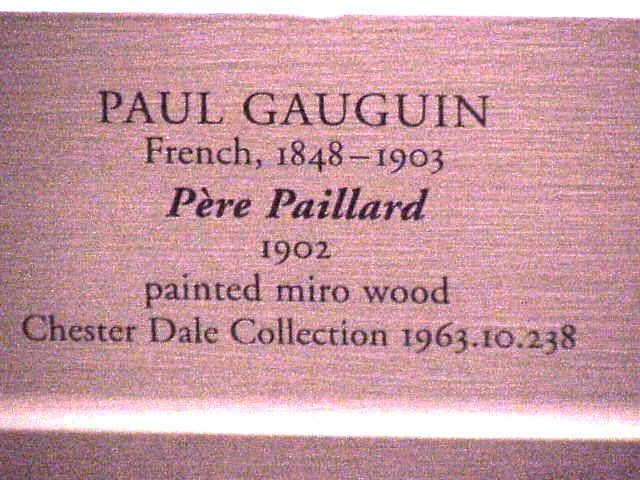| << Previous | Index | Next >> | ||
 |
 |
 |
 |
 |

Gauguin purposefully displayed his Père Paillard and its female companion piece, Thérèse, in front of his Polynesian home (which he named the House of Pleasure), so that islanders passing by could appreciate the two carved works. Their meaning was evident to everyone. From Père Paillard (Father Lechery or Debauchery) inscribed on its base, they recognized the local Catholic bishop, Monseigneur Martin, who entreated Gauguin to stop his liaisons with local women, while pursuing them himself (with Thérèse and others) despite his vows of celibacy. - Gauguin shows the bishop for what he considered him to be: a nude, horned devil. Though outwardly pious, Père Paillard's solemn expression and praying hands fail to mask his inner desires. Two nude women, carved in shallow relief near the base of the sculpture, may allude to his private predilection. Its specific context notwithstanding, the sculpture also forcefully embodies the artist's primitive aesthetic and anti-Western values. - Gauguin retained the cylindrical form of the miro wood log (native to the Marquesas Islands where he moved in his final years) in the finished figure, a reflection of his concept of beauty as a harmony between subject and material. For the most part, the sculpture's golden brown surface retains the primitive, rhythmic patterns of the artist's chisels and gouges; only the figure's cheeks, forehead, and jutting chin are filed smooth. Gold paint, used to accent the bishop's eyes, the women, and the inscription, has largely disappeared over time. - PAUL GAUGUIN - Père Paillard - 1902 - MATERIAL: Painted miro wood - DIMENSIONS: 67.9 x 18 x 20.7 cm (26 3/4 x 7 1/16 x 8 1/8 in.) - COLLECTION: National Gallery of Art, Washington DC. Chester Dale Collection
Photo album created with Web Album Generator